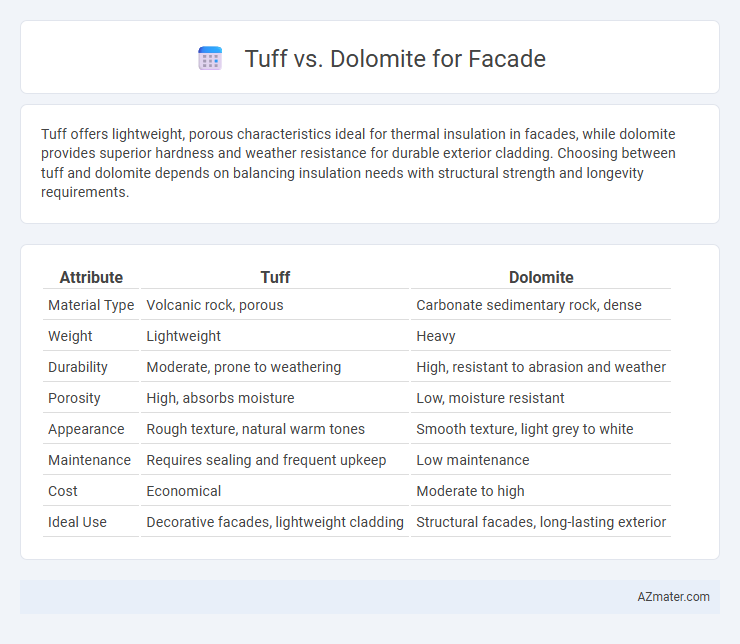Tuff offers lightweight, porous characteristics ideal for thermal insulation in facades, while dolomite provides superior hardness and weather resistance for durable exterior cladding. Choosing between tuff and dolomite depends on balancing insulation needs with structural strength and longevity requirements.
Table of Comparison
| Attribute | Tuff | Dolomite |
|---|---|---|
| Material Type | Volcanic rock, porous | Carbonate sedimentary rock, dense |
| Weight | Lightweight | Heavy |
| Durability | Moderate, prone to weathering | High, resistant to abrasion and weather |
| Porosity | High, absorbs moisture | Low, moisture resistant |
| Appearance | Rough texture, natural warm tones | Smooth texture, light grey to white |
| Maintenance | Requires sealing and frequent upkeep | Low maintenance |
| Cost | Economical | Moderate to high |
| Ideal Use | Decorative facades, lightweight cladding | Structural facades, long-lasting exterior |
Introduction to Tuff and Dolomite
Tuff is a porous volcanic rock known for its lightweight nature and excellent insulating properties, making it a popular choice for facades in both residential and commercial buildings. Dolomite, a sedimentary carbonate rock primarily composed of calcium magnesium carbonate, offers superior durability and resistance to weathering, ideal for long-lasting exterior cladding. Both materials provide unique aesthetic and structural benefits, influencing facade design choices based on climate, maintenance, and architectural style.
Geological Origins and Composition
Tuff is a volcanic rock formed from consolidated volcanic ash ejected during explosive eruptions, primarily composed of volcanic glass, minerals, and rock fragments. Dolomite is a sedimentary carbonate rock consisting mainly of the mineral dolomite (CaMg(CO3)2), formed through chemical alteration of limestone in shallow marine environments. The distinct geological origins influence their durability and texture, with tuff being more porous and lightweight, while dolomite offers greater hardness and weather resistance for facade applications.
Physical and Mechanical Properties
Tuff exhibits lower density and higher porosity compared to dolomite, resulting in reduced compressive strength and increased water absorption, which affects its durability in facade applications. Dolomite's superior hardness, typically over 3.5 on the Mohs scale, provides enhanced resistance to abrasion and weathering, making it more suitable for external cladding exposed to harsh environmental conditions. The mechanical properties of dolomite, including higher flexural strength and lower porosity, contribute to better structural integrity and longevity in facade construction compared to the more porous and softer tuff stone.
Aesthetic Appeal and Color Variations
Tuff offers a softer, earthy aesthetic with warm beige and brown tones ideal for natural, rustic facades, while dolomite provides a sleek, polished look with cooler grey and white hues suited for modern, minimalist designs. Dolomite's uniform texture allows for consistent color application, enhancing architectural precision, whereas tuff's porous surface generates unique, irregular patterns that emphasize organic beauty. Selecting between tuff and dolomite depends on the desired visual impact, whether embracing tuff's textured warmth or dolomite's refined elegance.
Durability and Weather Resistance
Tuff and dolomite both offer durable options for facades, but dolomite exhibits superior weather resistance due to its greater hardness and lower porosity. Dolomite's crystalline structure enhances its ability to withstand freeze-thaw cycles, acid rain, and abrasion, making it ideal for harsh climates. Tuff, while lighter and easier to work with, tends to absorb more moisture, which may lead to faster weathering and reduced lifespan in exposed environments.
Workability and Installation Process
Tuff offers superior workability for facades due to its softer texture, allowing easier cutting and shaping on-site, reducing labor time and tool wear. Dolomite, being denser and harder, requires specialized equipment and increased effort during installation, which can extend project timelines and labor costs. The ease of Tuff installation typically results in faster facade completion and lower overall expenses compared to the more rigid and tougher Dolomite material.
Cost Comparison and Availability
Tuff offers a more cost-effective solution for facade applications, with prices generally 15-25% lower than dolomite due to its abundant natural deposits. Dolomite's higher price stems from limited quarry locations and increased processing requirements to meet architectural standards. Availability of tuff is widespread in volcanic regions, ensuring steady supply, whereas dolomite's availability is regionally restricted, often leading to longer lead times and higher logistics costs.
Maintenance Requirements Over Time
Tuff requires minimal maintenance over time due to its porous yet resilient nature, which allows it to weather naturally without frequent cleaning or sealing. Dolomite, being denser and harder, demands occasional sealing and cleaning to prevent staining and maintain its polished appearance. Long-term maintenance costs are generally lower for Tuff, while Dolomite's durability offers better resistance to chipping and erosion with proper upkeep.
Environmental Impact and Sustainability
Tuff, a natural volcanic rock, offers lower environmental impact due to its abundant availability and minimal processing requirements, reducing carbon emissions compared to Dolomite, which involves more energy-intensive quarrying and calcination. Tuff's porous structure enhances thermal insulation, contributing to energy efficiency in building facades, whereas Dolomite's higher density may lead to increased thermal mass but less insulation. Sustainability in facade construction favors Tuff for its eco-friendly extraction and natural durability, promoting reduced resource depletion and better environmental stewardship.
Best Applications and Case Studies
Tuff offers exceptional thermal insulation and weather resistance, making it ideal for facades in regions with extreme temperature fluctuations, as demonstrated in the Mediterranean eco-housing projects. Dolomite's high compressive strength and aesthetic appeal suit urban commercial buildings, evidenced by its successful use in Singapore's Marina Bay Sands facade. Case studies reveal that Tuff excels in sustainability-focused designs, while Dolomite is preferred for structural durability and sleek architectural finishes.

Infographic: Tuff vs Dolomite for Facade
 azmater.com
azmater.com